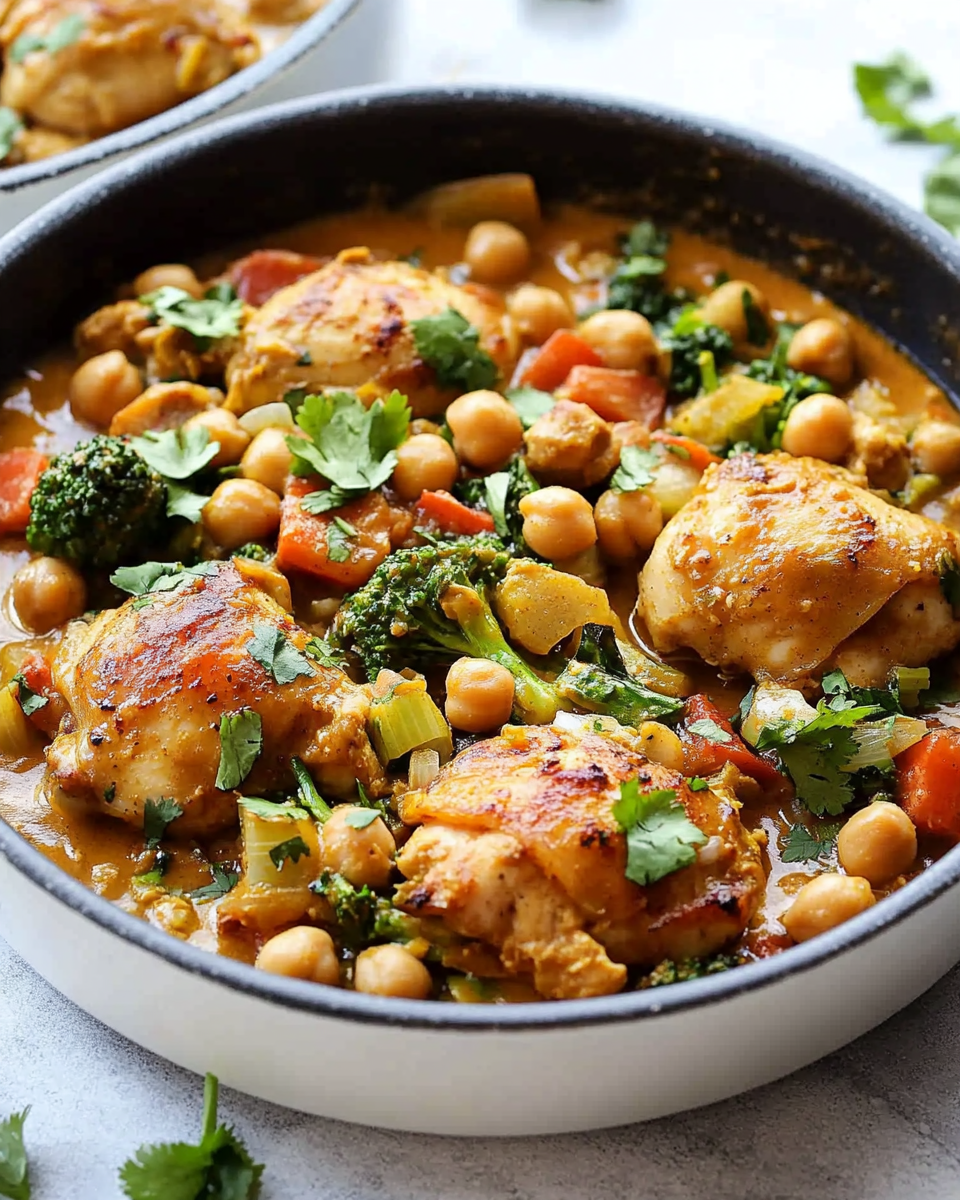A Symphony of Flavors and Aromatics
At the heart of this curry lies the delicious marriage between creamy peanut butter and rich coconut milk. Peanut butter lends a subtle sweetness and a unique nutty depth that elevates the sauce beyond typical curry bases. It provides a velvety texture that perfectly complements the natural creaminess of coconut milk. This luxurious sauce envelops each ingredient, allowing the bold Thai-inspired spices to shine through.
The carefully selected spices—paprika, cumin, cayenne, and ground ginger—work harmoniously to provide warmth, gentle heat, and a hint of earthiness. Paprika adds a smoky undertone, cumin contributes a rich, nutty flavor, cayenne pepper brings a controlled spiciness, and ginger offers a zesty, slightly peppery lift. Together, they craft a multi-dimensional spice profile that enhances the savory chicken and vegetables beautifully.
Lime juice introduces a fresh, tangy brightness that cuts through the richness of the peanut-coconut sauce. This citrusy note adds balance, keeping the dish lively and refreshing. Fresh cilantro sprinkled at the end imparts an herbal fragrance and a pop of color, making the curry as visually appealing as it is delicious.
Nutritional Powerhouse
This Healthy Thai Peanut Chicken Curry is a powerhouse of nutrition, offering a balanced blend of macronutrients and micronutrients essential for a well-rounded diet. The chicken thighs provide an excellent source of high-quality protein, crucial for muscle repair, immune function, and overall energy. Their natural fat content also contributes to the dish’s richness and satiety, while remaining moderate in comparison to fattier cuts.
Chickpeas enhance the nutritional value by supplying plant-based protein, complex carbohydrates, and dietary fiber. The fiber promotes digestive health and helps maintain a feeling of fullness, making this dish satisfying and weight-management friendly. Chickpeas are also rich in essential vitamins and minerals like folate, iron, and magnesium.
Coconut milk, particularly the full-fat variety, supplies healthy medium-chain triglycerides (MCTs) that are easier to digest and quickly converted into energy. These fats support metabolic health and provide a creamy texture without relying on dairy. The peanut butter further adds heart-healthy monounsaturated fats and protein, contributing to sustained energy release.
Vitamins A and C, abundant in the fresh vegetables and herbs, boost immunity and act as antioxidants, helping to protect cells from damage. Iron content supports oxygen transport in the blood, while calcium contributes to bone health. The sodium level is moderate but can be easily adjusted by choosing low-sodium broth and controlling added salt, making the dish adaptable to various dietary needs.
One-Pan Convenience and Cooking Technique
One of the biggest draws of this recipe is its simplicity and efficiency. Utilizing a single deep skillet means fewer dishes to clean and less kitchen hassle, which is invaluable for those with busy lifestyles. The cooking method ensures that flavors develop fully while allowing the chicken and vegetables to cook evenly.
Searing the chicken first is a key step, as it locks in juices and builds a rich foundation of flavor through caramelization. Adding onions, garlic, and broccoli next allows the aromatics to soften and mingle with the spices, enhancing the dish’s complexity. Incorporating the spices before adding the liquids helps to toast and intensify their flavors, resulting in a more fragrant and layered curry.
Simmering the mixture after adding coconut milk, broth, chickpeas, peanut butter, tomato paste, and lime juice enables the sauce to thicken naturally while melding all components into a harmonious whole. Adjusting the broth quantity during simmering allows for control over the curry’s consistency, from a thick stew to a lighter sauce, catering to personal preference.
Finishing the curry with fresh cilantro and optional spinach provides freshness, color, and an added nutrient boost, transforming the dish into a complete meal packed with texture and flavor.
Customization and Versatility
This curry is incredibly versatile and lends itself well to modifications based on availability, dietary needs, or flavor preferences. For those who enjoy a spicier dish, increasing the cayenne pepper or adding fresh chilies can easily amp up the heat. Alternatively, for a milder curry, cayenne can be reduced or omitted altogether.
Vegetables can be customized seasonally or based on preference. Adding bell peppers, snap peas, zucchini, carrots, or mushrooms provides additional texture and nutritional variety. For extra greens, stir in kale or swiss chard instead of or in addition to spinach. The protein source can also be switched up: tofu, shrimp, or even firm white fish work well as alternatives to chicken.
For a lower-fat version, light coconut milk can be used, and peanut butter choices should be natural with no added sugar or hydrogenated oils. This adaptability makes the recipe suitable for gluten-free, paleo, and dairy-free diets.
Serving Suggestions
Serving this Healthy Thai Peanut Chicken Curry over jasmine rice, brown rice, or quinoa provides a perfect starch base that soaks up the flavorful sauce. Jasmine rice adds a fragrant, slightly floral note, while brown rice and quinoa contribute additional fiber and protein, making the meal more filling and balanced.
For those looking to keep carbs low, serving the curry over cauliflower rice or spiralized vegetables is an excellent option. Garnishing with extra chopped cilantro, crushed peanuts, or a squeeze of lime juice just before serving elevates the presentation and flavor.
This dish pairs wonderfully with light, refreshing side salads or steamed vegetables, which add contrast and balance to the richness of the curry. A crisp cucumber salad with a tangy vinaigrette complements the creamy peanut sauce beautifully.
Why Healthy Thai Peanut Chicken Curry is a Go-To Meal
This recipe strikes the perfect balance between healthfulness and indulgence, making it a staple for those who want to enjoy flavorful meals without sacrificing nutrition or convenience. It caters to a wide range of dietary preferences and is simple enough to prepare on busy nights but impressive enough to serve to guests.
Its one-pan preparation saves time and effort, and the ability to customize ingredients means it never gets boring. The robust flavors combined with nourishing ingredients ensure it satisfies cravings while fueling the body well.
Conclusion
Healthy Thai Peanut Chicken Curry is a delicious, wholesome, and efficient meal that brings bold Thai flavors into your kitchen with ease. With tender chicken thighs, creamy peanut-coconut sauce, protein-packed chickpeas, and fresh vegetables, it delivers a satisfying and balanced dish that fits into a variety of dietary lifestyles.
Ready in under 30 minutes and requiring only one pan, it offers convenience without compromising on quality or nutrition. Whether you’re looking for a quick weeknight dinner or a nutritious meal prep option, this curry is a flavorful, comforting choice destined to become a family favorite. Its rich, layered flavors and adaptable ingredients make it a versatile recipe that can be enjoyed any time of the year, bringing warmth, spice, and nourishment to your table.

